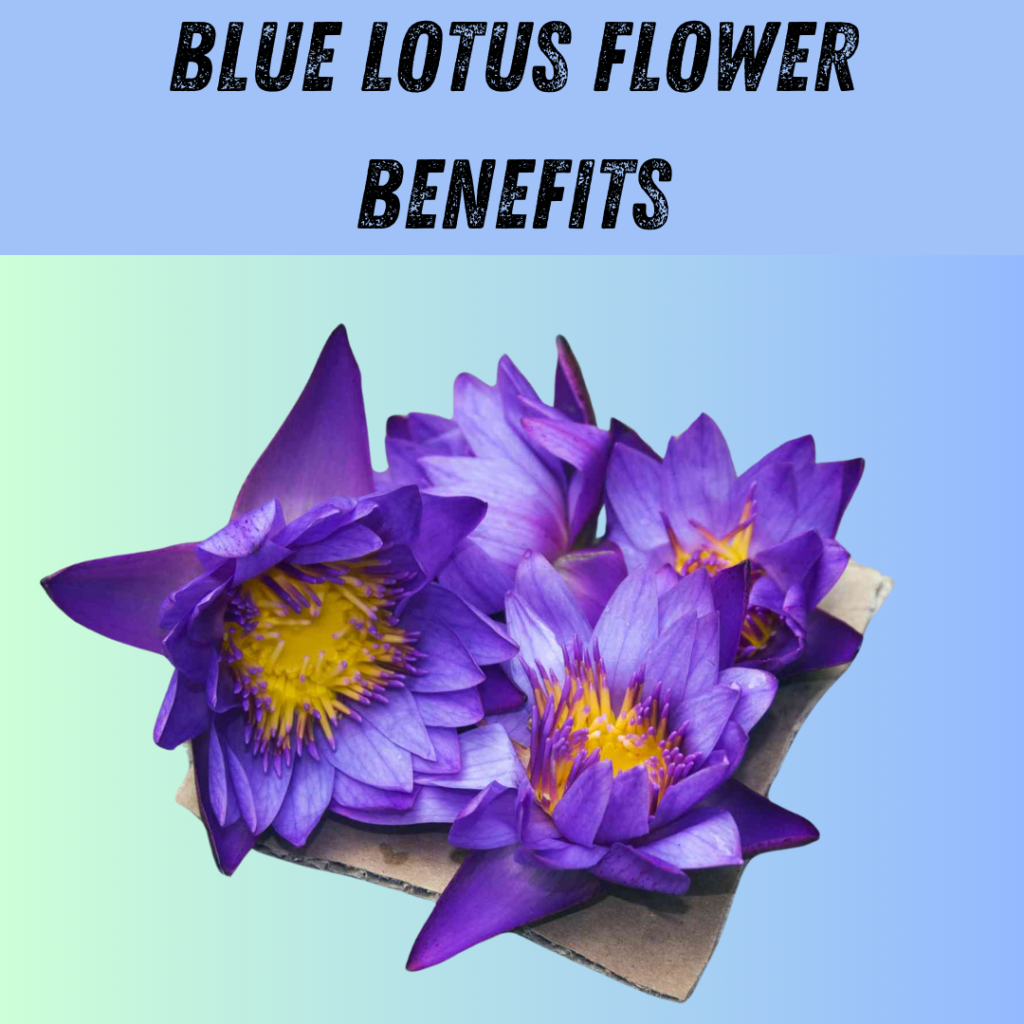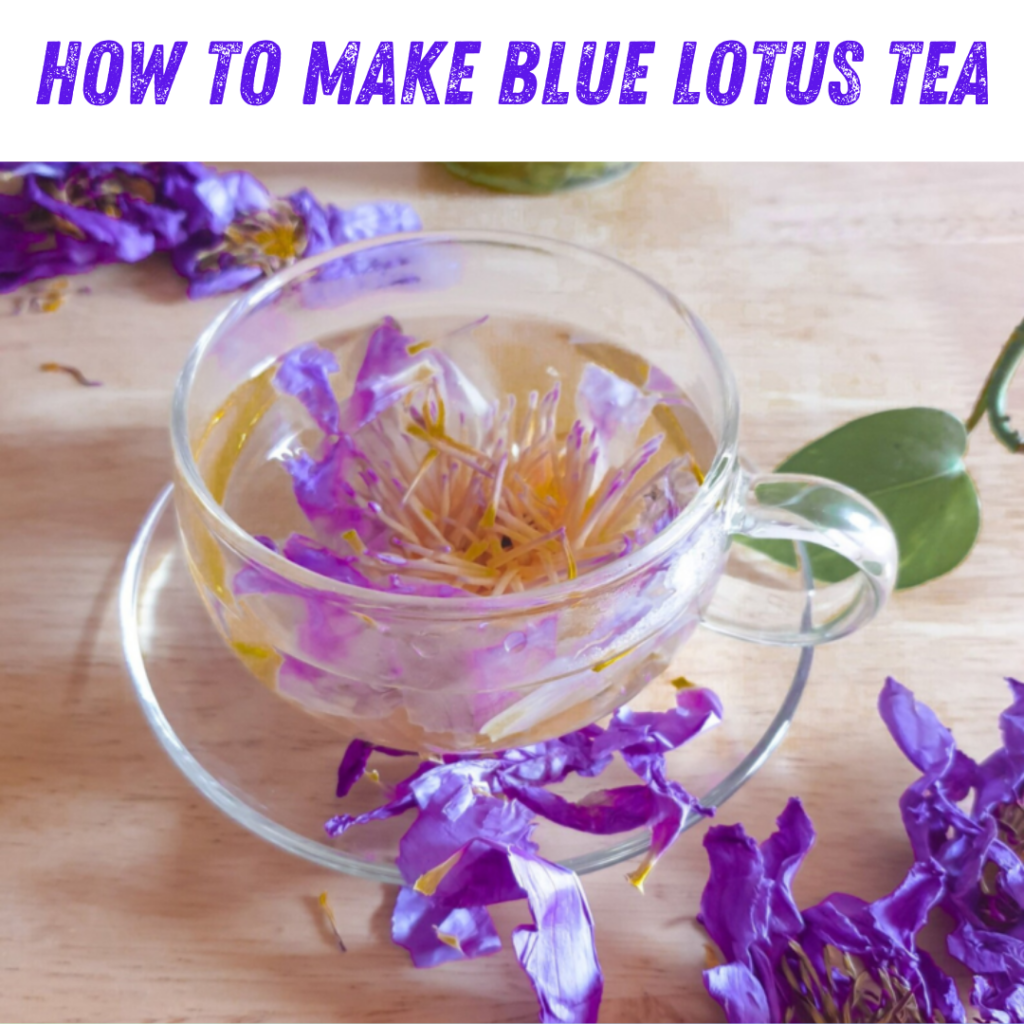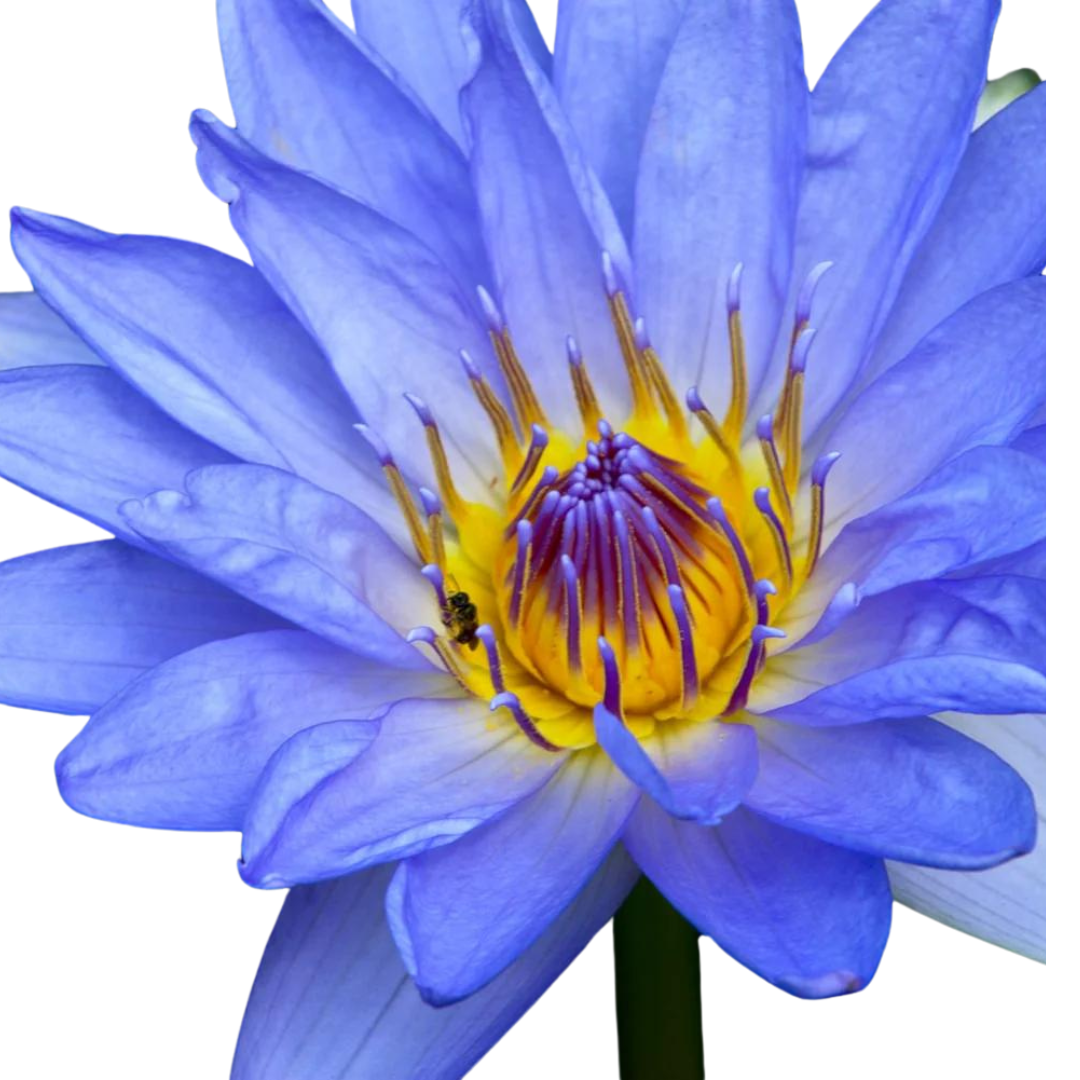Type : Aquatic plant
Natural Habitat : Freshwater lakes, pools, and rivers in eastern Africa and southern Arabia
Cultural Significance : Grown and revered by Ancient Egyptian civilization
The Blue Lotus Flower (Nymphaea caerulea), also called the Egyptian Lotus, Blue Water Lily, or Sacred Blue Lily, is a beautiful water plant that has amazed people for thousands of years. Known for its stunning looks and important history, this flower symbolizes peace, spiritual growth, and new beginnings.
In this article, we’ll explore the fascinating world of the Blue Lotus Flower, looking at its history, meaning, and modern uses.
Historical Significance
The Blue Lotus Flower: A Symbol of History, Culture, and Spirituality
The blue lotus flower (Nymphaea caerulea), also known as the blue Egyptian lotus or blue water lily, holds deep historical and cultural significance across ancient civilizations, particularly in Egypt, India, and among Buddhists. Here is a detailed look at its importance:
Ancient Egypt
Symbolism: In ancient Egyptian culture, the blue lotus was closely tied to the sun god Ra and the god of the underworld, Osiris. The flower’s daily cycle of blooming with the sunrise and closing at sunset symbolized rebirth and the eternal cycle of life and death.
Religious and Ceremonial Use: The blue lotus played a key role in religious ceremonies and shamanistic rituals. It was believed to provide a spiritual connection to the afterlife and facilitate communication with the divine. Often depicted in Egyptian art, hieroglyphics, and tombs, it symbolized the journey of the soul into the afterlife.
Medicinal and Psychoactive Properties: Egyptians used the blue lotus for its medicinal properties and psychoactive effects. Consumed in various forms, such as steeped in wine, it was used to induce relaxation, alleviate pain, and enhance spiritual experiences.
Buddhism and Hinduism
Buddhism: In Buddhist tradition, the blue lotus symbolizes wisdom, knowledge, and the victory of the spirit over the senses. It represents purity and enlightenment, emerging untainted from muddy waters, reflecting the human soul’s journey toward spiritual realization.
Hinduism: In Hindu culture, the blue lotus is a symbol of divine beauty and spiritual enlightenment. It is often associated with deities like Vishnu and Saraswati, representing their transcendent qualities and wisdom.
Cultural Significance
Art and Literature:
Depictions in Art: The blue lotus frequently appears in ancient Egyptian art, including murals, pottery, and jewelry, symbolizing its importance in daily life and cultural beliefs.
Literature: References to the blue lotus can be found in various ancient texts, such as the Egyptian Book of the Dead, where it is mentioned as a symbol of rebirth and resurrection.
The blue lotus flower’s enduring legacy is a testament to its profound impact on history, culture, and spirituality. Its symbolism of rebirth, purity, and enlightenment continues to inspire and captivate people around the world.
Benefits of the Blue Lotus Flower

1. Anxiety and Stress Relief
The blue lotus flower helps reduce anxiety and stress. Its calming effects come from natural compounds like apomorphine and nuciferine, which interact with dopamine in the brain to create a sense of calm and relaxation.
2. Sleep Aid
This flower is a natural remedy for insomnia and other sleep problems. Apomorphine and nuciferine help you relax and reduce anxiety, making it easier to fall asleep and stay asleep.
3. Aphrodisiac Properties
The blue lotus flower is known to boost sexual performance and desire. It has been used to improve libido and help with erectile dysfunction by enhancing blood flow and muscle control.
4. Mood Enhancement
Compounds in blue lotus can create a mild euphoria and improve mood. This effect is similar to the high from cannabis, but milder. This mood boost can make you feel happier and more mentally clear.
5. Antioxidant Properties
Blue lotus is rich in antioxidants like flavonoids, quercetin, kaempferol, and myricetin. These help fight oxidative stress and protect cells from damage, reducing the risk of chronic diseases like heart disease, diabetes, and certain cancers.
6. Skin Health
The flower is also great for skin care. Its antioxidants and nutrients can promote collagen production, maintain skin elasticity, and reduce fine lines and wrinkles. The blue lotus flower helps to maintain healthy and glowing skin.
7. Pain Relief
Nuciferine in blue lotus interacts with dopamine receptors to relieve pain and reduce inflammation. This makes it helpful for treating conditions like neuropathic pain and inflammation-related depression.
8. Digestive Health
Drinking blue lotus tea can improve digestion by promoting the release of gastric and digestive juices. This helps your body absorb nutrients better and improves overall digestive function.
Methods of Consuming Blue Lotus Flower
Tea
How to Use: Steep dried blue lotus flowers in hot water to make a calming tea.
Benefits: Offers relaxation and stress relief.
Smoking/Vaping
How to Use: Smoke or vaporize dried petals.
Benefits: Often produces more intense effects than tea.
Tinctures and Extracts
How to Use: Add concentrated forms of blue lotus to beverages or take them directly.
Benefits: Provides a potent dose of its beneficial compounds.
Skincare Products
How to Use: Use in facial packs, scrubs, and cleansers.
Benefits: Provides anti-aging and antioxidant benefits for the skin.
Safety and Side Effects
The blue lotus flower (Nymphaea caerulea), while offering several potential benefits, also comes with various safety concerns and potential side effects. Here are the details of these aspects:
Common Side Effects
Mild Sedation: The blue lotus flower can cause drowsiness and mild sedation, making it unsafe to operate machinery or drive while under its influence.
Dizziness and Confusion: Users may experience dizziness and confusion, especially at higher doses.
Dry Mouth: Another common side effect is dry mouth, which can be uncomfortable for some users.
Gastrointestinal Issues: Nausea and vomiting are potential side effects, particularly when the flower is consumed in large amounts.
Slurred Speech and Chest Pain: Some users report slurred speech and chest pain, which can be alarming and may require medical attention.
Paranoia and Anxiety: Although the flower is often used to alleviate anxiety, in some cases, it can paradoxically cause anxiety and paranoia, especially at higher doses or when combined with other psychoactive substances.
Serious Side Effects
Hallucinations: At higher doses, blue lotus can cause hallucinations and perceptual disturbances.
Rapid Heartbeat and Seizures: There have been reports of rapid heartbeat (tachycardia) and seizures following the use of blue lotus products, particularly when vaped or consumed in large quantities.
Altered Mental Status: Cases of altered mental status, including severe agitation and decreased responsiveness, have been reported, necessitating emergency medical care.
Drug Interactions
Sedatives and Antipsychotics: Blue lotus may enhance the effects of sedatives and antipsychotic medications, leading to excessive drowsiness or other adverse effects.
Erectile Dysfunction Medications: Apomorphine, a compound in blue lotus, is also used in some erectile dysfunction treatments. Concurrent use with similar medications could amplify effects and side effects.
Diabetes Medications: There is some concern that blue lotus might lower blood sugar levels, which could interact with diabetes medications, potentially leading to hypoglycemia.
Precautions
Pregnancy and Breastfeeding: Due to the lack of research on its safety, blue lotus is not recommended for pregnant or breastfeeding women.
Allergic Reactions: Individuals with known allergies to similar plants should exercise caution, as allergic reactions such as skin rashes, eye irritation, and respiratory difficulties can occur.
Surgery: Blue lotus might interfere with blood sugar control during and after surgery. It’s recommended to discontinue use at least two weeks before any scheduled surgery.
Legal Status
United States: Blue lotus is not approved for human consumption by the FDA but is not classified as a controlled substance. It is legal to purchase and cultivate in most states, except Louisiana.
International: The flower is illegal in some countries, including Poland, Russia, and Latvia.
General Recommendations
Start with Low Doses: Due to the variability in individual responses and the lack of standardized dosing guidelines, it is recommended to start with small amounts and gradually increase to assess tolerance and effects.
Consult Healthcare Providers: Always consult with a healthcare provider before starting any new supplement, particularly if you have underlying health conditions or are taking other medications.
In conclusion, while the blue lotus flower has potential benefits, especially for relaxation and anxiety relief, its safety profile is not well-established. Users should proceed with caution, starting with low doses and consulting healthcare providers to avoid adverse effects and interactions with other medications.
How to Make Blue Lotus Tea

The best way to prepare blue lotus tea involves a few key steps to ensure you extract the optimal flavor and benefits from the dried flowers. Here is a detailed guide based on various sources:
Ingredients and Tools
Dried Blue Lotus Flowers: Use high-quality, organically grown flowers.
Filtered Water: Fresh, filtered water is preferred for the best taste.
Teapot or Infuser: A teapot or infuser that allows the flowers to expand.
Optional Sweeteners: Honey, agave, or your preferred sweetener.
Step-by-Step Preparation
1. Measure the Flowers
Use approximately 1-2 whole flowers or 1-2 teaspoons of dried petals per cup of water (about 250 ml).
2. Heat the Water
Bring the water to a boil and then let it cool slightly to about 180°F (82°C) to 200°F (93°C). Using water that is too hot can damage the delicate compounds in the flowers.
3. Steep the Flowers
Place the dried blue lotus flowers in your teapot or infuser.
Pour the heated water over the flowers, ensuring they are fully submerged.
Let the tea steep for 5-10 minutes. The steeping time can vary based on personal preference and how strong you want the tea to be.
4. Strain and Serve
After steeping, strain the tea to remove the flowers.
Pour the infused tea into your favorite teacup.
Add honey or another sweetener to taste if desired.
5. Enjoy
Take a moment to appreciate the floral aroma and the soothing effects of the tea. Blue lotus tea can be enjoyed hot or cold, depending on your preference.
Additional Tips
Cold Brewing: For a refreshing alternative, you can cold brew blue lotus tea by combining the dried flowers with cold water in a jar or pitcher and letting it steep in the refrigerator for at least 6 hours or overnight.
Blends: Experiment with blending blue lotus flowers with other herbs like chamomile, lavender, or mint to enhance the flavor and benefits.
Precautions
Dosage: Start with small amounts to gauge your response, as there is no standardized dosage.
Consult Healthcare Providers: Especially important if you have underlying health conditions or are taking other medications.
Pregnancy and Breastfeeding: Not recommended due to lack of research on safety.
Also read: Lavender Tea: 10 Health Benefits, history & Brewing

